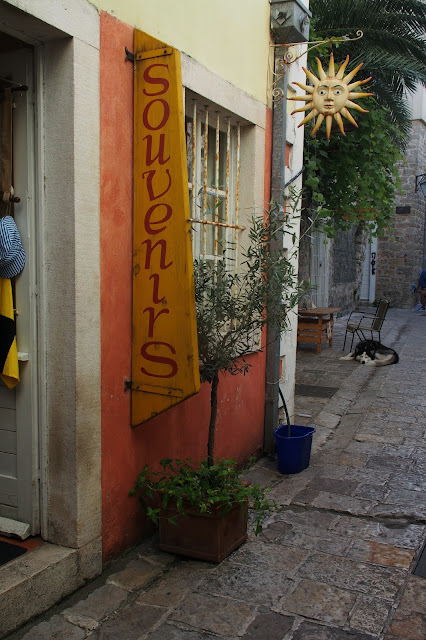
Our first sight of another little 3,500 year-old coastal town in Montenegro called Budva (Будва in Montenegrin and Serbian and Budua in Italian and Μπούντβα in Greek)
with some 18,000 locals living there, mostly Serbian with a smattering of Muslims and Croats. It forms part of the so-called "Budvanska
rivijera", famous for its sandy beaches, diverse nightlife, and
samples of Mediterranean architecture . It now has more than half a million
visitors a year but tourism also brought problems, mainly
shortage of water, electricity and parking spaces.
According to historians, some people were already living there in 5th
century BC.Legend has it that the town was founded by Cadmus the
Phoenician, a Thebean exile. A bone of contention between ancient
Greece and Rome, upon the fall of the Roman Empire which divided into Roman Empire and the Eastern Roman Empire, Budva became the defensive barrier which separated the two powers. In the Middle Ages, Budva was reigned
by a succession of Doclean kings, as well as Serbian and Zetan
aristocrats.For close to 4 centuries, from 1420 to 1797, it was ruled by the Venetian Republic which
strengthened its fortifications against the Ottoman Turks and until
early 19th century the people there spoke Venetian.Then it was ruled
successively by Austria, France and Russia. In 1813-1814, Boka Kotorska
and Budva joined Montenegro in an alliance and thereafter until the end of WWI in
1918, it became part of the Austrian Empire after that part of
the Kingdom of Yugoslavia but it was annexed by the Kingdom of Italy in
1941 and upon being liberated from the Fascists at the end of 1944, it reverted to
Yugoslavia. It's now part of the newly independent Montenegro.But the
town was rocked by an earthquake on 15 April 1979 which devastated most of its
old buildings. It took them some 8 years to have them restored to
their original form. The Old Town, along with the city of Budva was said
to have been discovered by a Greek sailor by the name of Boutoua.
Eventually the Roman Empire took over the whole Montenegrin coast but since it was under Venetian rule for 4
centuries, much its architecture is Venetian in design but many doors,
hinges, windows, balconies and many other small but noticeable things remained Romaneque. The town has a
typical Mediterranean climate, with warm summers and mild winters, and
230 sunny days in a year. Budva is referred to by the locals as the
Montenegrin Kuwait, because of the number of resident millionaires
compared to its relatively small population: there are
approximately 500 millionaires in that town of around 22,000 people. Many
of the newly rich re-invested their money in real-estate, buying homes
in central Podgorica and Belgrade, which resulted in higher real-estate
prices in Podgorica and Belgrade.
There were lavenders everywhere
A close up of two of them
The old city wall
a look-out tower
A view from the city wall
A boat taking to the sea
The path to the sea wall
An old fashioned canon
An old fashioned lamp sticking out from the strong stone masonry. I like the fern behind it which seemed to form part of its decorations.
part of the old fortifications
The entrance to the maritime museum
a model ship on display
A 3-rig ship with sails against the winds
another one, much broader
Another ship showing the Christian cross
An older model
This one has a much shallower body
Another one
A catapult
The library
A bust on the shelf
The entrance lobby
The staircase landing
The entrance to the museum
There is a bridge joining the museum to the sea wall
The Holy Trinity, which was built in 1804.
Another view of the same church
Flower decoration for a roadside restaurant. The town once hosted a Rolling Stones concert
A roadside fountain fountain
A terraced restaurant with a ship's mast as decoration
The streets were quite narrow
Another alley
Pottery for sale
And sourvenirs
An antique shop
beautiful back on the way to the beach
The entrance to the beach
Mogren, Budva's most famous beach
Children having fun. We were told by our guide that sometimes we might find topless girls. I certainly did this time.
Tourists having fun
Flowers growing close to a wall
flowers on restaurant tables
the narrow alleys were not wasted
A table outside one of the local restaurants
table nicely laid out
Fish anyone?
Bagel and snacks
There were some residences inside the old town too
Creepers on the wall
And some purple flowers too
We had to pay to go up the sea wall at one end of which is a restaurant on the terrace facing the sea
A view of the terrace restaurant
The steps to the sea wall
The small island opposite to the old town
facilities for boating
A closer view of the boating facilities: there's even a small church on the tiny island
Its stony outcrop
rows and rows of bodies absorbing the Adriatic sun
The buoys marking out safety limits
A more distant view of the beach
A view of the old town
Another view of the old town and adjacent beach
The museum facing the sea
Clouds above the old town
A view of the beach and the old town
A boat speeding across the mouth of the bay
The sea wall
There
are also three main churches in the old town viz. St. Ivan's, built in
the 7th century; St. Mary's of Punta dating from 840 and the Trinity Church in the 19th century.
Jet streams clouds
The sea wall
Part of the sea wall
A view of the fortifications at one end of the seawall
boats all ready to take tourists out on a ride. not expensive. just $5 euros per head but we didn't have time


A closer view of one of them

And food right under the city wall !









































































沒有留言:
張貼留言